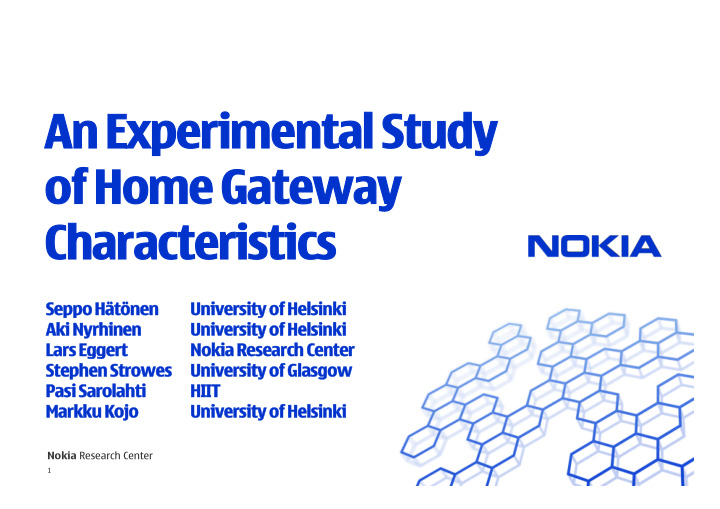



An An Experi rime mental l Study y of Home me Gatewa way y Ch Chara ract cteri rist stics cs Seppo Seppo Hätönen Hätönen Universi rsity y of Helsi lsinki Ak Aki Nyrh yrhinen Universi rsity y of Helsi lsinki Lars rs Eggert rt Nokia Resea search rch Ce Center r Stephen Stephen Stro rowe wes Universi rsity y of Gla lasg sgow w Pasi si Saro rola lahti HIIT HIIT Mark rkku Kojo Kojo Universi rsity y of Helsi lsinki Nokia Research Center 1
Motivation Motivation • CPE boxes (“home gateways”) are everywhere • their characteristics and behaviors vary widely • they control the quality and performance of consumer Internet access • most “standards” are about the control plane – but the data plane counts • very few studies of home gateway behavior are (publicly) available • just lots of second-hand hear-say Nokia Research Center 2
Ap Appro roach ch Setup Measure • collect devices • run tests • design tests • collect data This is next You are here Feedback Analyze • methods • process data • other tests • scratch head Publicize • write paper • give talks Nokia Research Center 3
Setup: : Device ce Co Colle llect ction • HU and Nokia bought 20 devices to seed the testbed • another 14 were donated • 34 devices tested in total • follow-up studies planned; many more donations in the meantime • talk to me if you have a spare box! Nokia Research Center 4
Setup: : Test stbed Nokia Research Center 5
Test sts s & Resu sult lts s Nokia Research Center 6
UDP Binding Time meouts s UDP-1: Single packet, outbound only • measures NAT UDP binding timeout after client sends a single packet • server sends no return traffic • result: very short timeouts (min = 30 sec), almost all less than IETF recommendation IETF recommendation Nokia Research Center 7
UDP Binding Time meouts s UDP-2: Single packet outbound, multiple packets in- bound • client sends a single UDP packet to the test server and then remains silent • server then sends a stream of responses, increasing delay between each • result: longer timeouts overall; some boxes shorter compared to UDP-1 IETF recommendation Nokia Research Center 8
UDP Binding Time meouts s UDP-3: Multiple packets out- and inbound • similar to UDP-2, except that client sends response to each server packet • intent is to determine whether outbound traffic refreshes a binding • result: longer timeouts overall; no boxes shorter compared to UDP-2 IETF recommendation Nokia Research Center 9
TCP CP Binding Time meouts s • similar to UDP-1, except TCP connection (no keep-alives) • note: log scale and unit different! • result: some short timeouts (min = 4min), longer than half less than IETF recommendation 24h IETF recommendation Nokia Research Center 10
TCP CP Thro roughput • throughput over of a 100 MB bulk transfer (2x unidirectional, 1x bidirectional) • result: 1/3 of boxes reaches max, median in bidirectional case much less than when sending unidirectional, lots of weirdness Nokia Research Center 11
Queuing Dela lays ys • queuing delay introduced by the box when fully loaded • result: mostly OK (< 50 ms); some boxes really bad/weird Nokia Research Center 12
Max. Numb mber r of TCP CP Bindings s • maximum number of TCP bindings allowed to a single server port • result: some very low (16), max. is 1024 Nokia Research Center 13
Other r Resu sult lts s DCCP & SCTP • DCCP : zilch • SCTP : 18/34 ?!? • theory: single SCTP association “works”, because those 18 devices translate just the IP addresses for unknown IP protocol numbers • need to look deeper Nokia Research Center 14
Other r Resu sult lts s DNS • DNS over UDP : worked • DNS over TCP : so-so • 14 accept connections on TCP port 53 • 10 respond to DNS queries • one box forwards inbound DNS-over- TCP as DNS-over UDP Nokia Research Center 15
Other r Resu sult lts s ICMP handling • in a nutshell: many issues • one box doesn’t translate ICMP at all • all others translate at least “Port unreachable” and “TTL Exceeded” • one box translates TCP-related ICMP messages into TCP RST • 16 out of 34 do not correctly translate the transport header contained in the ICMP payload • two do not correctly translate the IP checksum in the ICMP payload Nokia Research Center 16
Next Steps: s: Refine & Expand the Study y Setup Measure • collect devices • run tests • design tests • collect data This is next You are here Feedback Analyze • methods • process data • other tests • scratch head Publicize • write paper • give talks Nokia Research Center 17
Rela lated Work rk • L. D’Acunto, J. Pouwelse, and H. Sips. A Measurement of NAT & Firewall Characteristics in Peer to Peer Systems. In Proc. ASCI Conference, 2009. • B. Ford, P. Srisuresh, and D. Kegel. Peer-to-Peer Communication Across Network Address Translators. In Proc. USENIX Annual Technical Conference, pages 13–13, 2005. • S. Guha and P. Francis. Characterization and Measurement of TCP Traversal through NATs and Firewalls. In Proc. ACM SIGCOMM IMC, pages 199–211, 2005. • C. Jennings. NAT Classification Test Results. Internet-Draft draft-jennings- behave-test-results-04, Internet Engineering Task Force, July 2007. Work in Progress. • L. Mäkinen and J. Nurminen. Measurements on the Feasibility of TCP NAT Traversal in Cellular Networks. In Proc. Conference on Next Generation Internet Networks, pages 261–267, 2008. Nokia Research Center 18
Thank You Thank You Talk lk to me me if yo you have a sp spare re home me gatewa way y to donate to the test stbed. la lars. rs.eggert rt@nokia.co com Nokia Research Center 19
Recommend
More recommend